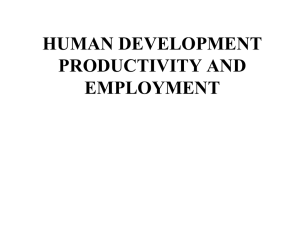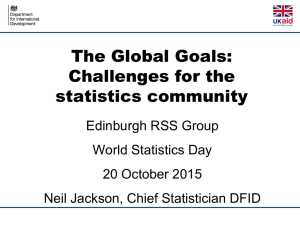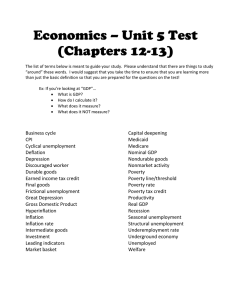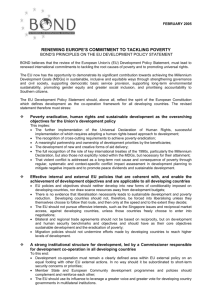The Road from Rio: trade, a key fellow traveller Ransford Smith
advertisement
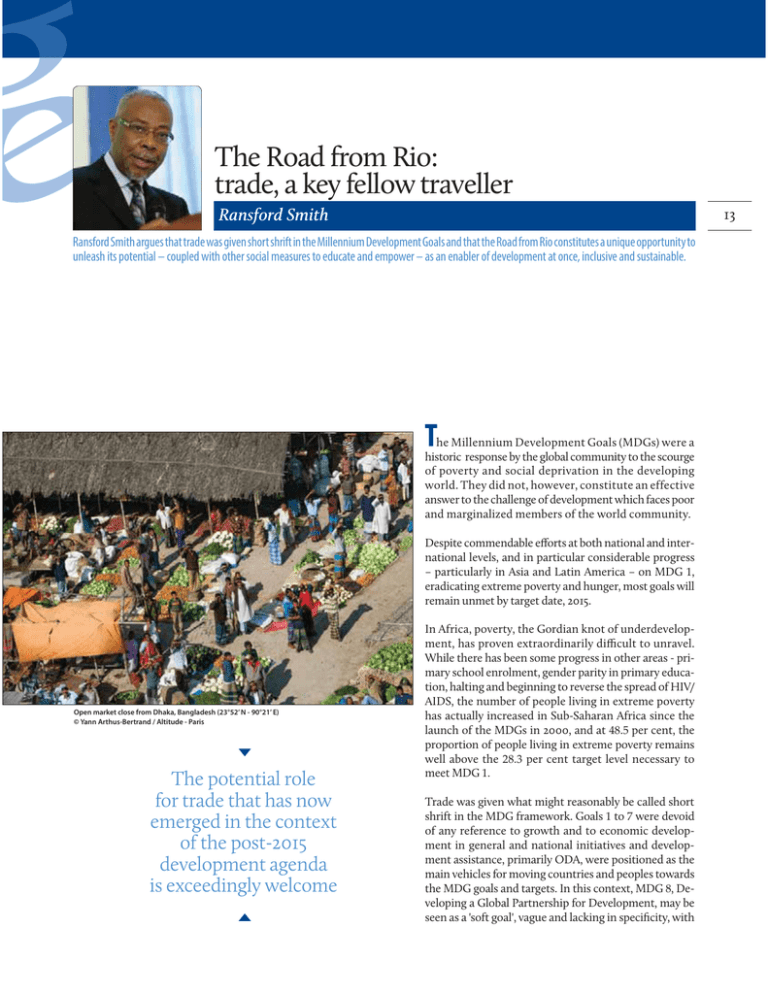
The Road from Rio: trade, a key fellow traveller Ransford Smith 13 Ransford Smith argues that trade was given short shrift in the Millennium Development Goals and that the Road from Rio constitutes a unique opportunity to unleash its potential – coupled with other social measures to educate and empower – as an enabler of development at once, inclusive and sustainable. T he Millennium Development Goals (MDGs) were a historic response by the global community to the scourge of poverty and social deprivation in the developing world. They did not, however, constitute an effective answer to the challenge of development which faces poor and marginalized members of the world community. Despite commendable efforts at both national and international levels, and in particular considerable progress – particularly in Asia and Latin America – on MDG 1, eradicating extreme poverty and hunger, most goals will remain unmet by target date, 2015. Open market close from Dhaka, Bangladesh (23°52’ N - 90°21’ E) © Yann Arthus-Bertrand / Altitude - Paris The potential role for trade that has now emerged in the context of the post-2015 development agenda is exceedingly welcome In Africa, poverty, the Gordian knot of underdevelopment, has proven extraordinarily difficult to unravel. While there has been some progress in other areas - primary school enrolment, gender parity in primary education, halting and beginning to reverse the spread of HIV/ AIDS, the number of people living in extreme poverty has actually increased in Sub-Saharan Africa since the launch of the MDGs in 2000, and at 48.5 per cent, the proportion of people living in extreme poverty remains well above the 28.3 per cent target level necessary to meet MDG 1. Trade was given what might reasonably be called short shrift in the MDG framework. Goals 1 to 7 were devoid of any reference to growth and to economic development in general and national initiatives and development assistance, primarily ODA, were positioned as the main vehicles for moving countries and peoples towards the MDG goals and targets. In this context, MDG 8, Developing a Global Partnership for Development, may be seen as a 'soft goal', vague and lacking in specificity, with Against this background, the potential role for trade that has now emerged in the context of the post-2015 development agenda is exceedingly welcome. While specific elements of the agenda will ultimately be defined through UN inter-governmental processes in New York, it is evident, following the Rio+20 conference, that sustainable development anchored in social, economic and environmental pillars, and poverty eradication, will be its core. The Road from Rio thus takes us inevitably towards inclusive development. Importantly, we believe that growth and equity constitute the indispensable scaffolding for development that is sustainable and inclusive. This brings us back to trade and why trade is critical to the post-2015 development agenda. We must ensure that trade's potential as a driver of growth and poverty eradication through the productive employment of people, and the exchange of essential goods and services, is fully realized. This role is magnified by the prominence of trade in the Gross Domestic Product (GDP) of developing countries as a whole, and especially so for many poor and small countries. Furthermore, it is a role made even more salient by the fact that trade has the capacity to be both a macro-enabler and a micro-enabler of Sustainable Development Goals (SDGs). In its role as a macro-enabler trade will contribute to GDP expansion, to employment and to revenue generation by Governments. These are channels through which individuals productively employed can improve the quality of life for themselves and their families, and through which Governments can provide and improve the quality of public services such as health, education, sanitation and water, and transportation, and as well, developmental infrastructure such as telecommunications, roads and ports. As a micro-enabler, trade lends itself to specific measures at the product and sector level – taken unilaterally or in regional and multilateral contexts – to promote desirable social and economic outcomes – such as removing duties from environmental goods, from educational and health items, or from basic consumer goods. East Asia the poster region for poverty reduction, and which achieved MDG 1 more than ten years ago, offers dramatic evidence of the role that trade can play in economic growth and poverty reduction. But it also provides clear evidence that the impact of economic growth on poverty will differ from country to country and, by extension, from region to region. It is thus evident that in order to move beyond trade expansion and economic growth to inclusive development, and especially to ensure major reduction in and eradication of extreme poverty, other measures will be required. These measures should, for example, be directed at promoting through the provision of targeted education and skills training the fullest possible participation in economic activity by marginalized groups, such as women, youth, and the rural and urban poor. Social policies, including safety nets and targeted transfers, should respond to the needs of those in danger of being left behind. Increasing revenues accruing to government – much of it derived from the dynamic trade sector – should be equitably directed towards social infrastructure and services that empower the poorest and most marginalized and improve their living conditions. Trade now constitutes the major share of GDP in many developing countries and a substantial share of GDP in most developed countries. Indeed, in low income countries trade constitutes more than a half of GDP (53 per cent) and for many small economies the proportion is much higher. The challenge is to ensure that trade openness and expansion promotes economic growth which leads to inclusive development and to the elimination of extreme poverty. There is every reason to believe that with commitment and partnership at the national and international levels, this challenge can be met. The Road from Rio should witness trade's evolution from Engine of Growth to Enabler of the SDGs Δ 14 a mix of un-related targets and inadequate indicators that cover inter alia development of a non-discriminatory trading and financial system, debt sustainability, certain areas of market access, youth employment, access to medicines, and access to information and communications technology. The prospect of fulfilling those aspects of MDG 8 related specifically to trade was in any event impaired in the period since the Millennium Summit by the long stalemated WTO Doha Round, a situation that will be redressed only if the recent modest but welcome Bali Package of the WTO Ministerial Conference proves to be profoundly catalytic. About the author Ransford Smith is a career diplomat, former Permanent Representative of Jamaica to the WTO and UN organizations in Geneva; and former Deputy Secretary-General of the Commonwealth Secretariat.
